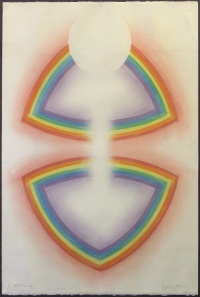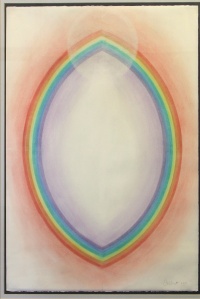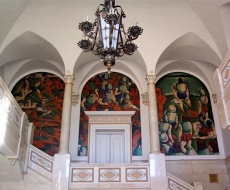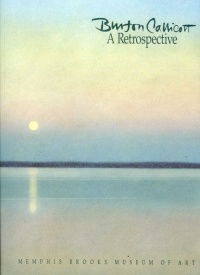Burton Callicott
Burton Harry Callicott was an art professor from Memphis, Tennessee who incorporated Theosophical concepts into his paintings and drawings. His work has been described as "the relationship between nature and the human spirit, epitomized in the effects of light."[1] Three of his paintings were donated by the artist and his family for the collection of the Theosophical Society in America: Antahkarana, Mandorla, and Mandorla #12.
Personal life
Burton Callicott and his fraternal twin brother William were born December 28, 1907 in Terre Haute, Indiana. When he was four years old, his family moved to Memphis. After graduation from the Cleveland School of Art in 1931, he returned to Memphis to teach in public schools. Like many Depression-era artists, he found temporary employment within a federal agency. The Federal Public Works of Art Program commissioned him to paint murals for the stairway of the Pink Palace Museum. The exploration of the Mississippi River by Hernando de Soto was the subject of the murals.[2][3]
During this period, Callicott began working with his stepfather Michael Abt in the design of floats for the Memphis Cotton Carnival and Christmas parades. They shared this activity for 20 years beginning in 1932.
Evelyne Baird married Burton Callicott in 1932, and they spent more than 60 years together. The couple had two children. Their small house in Memphis had an artist's studio with north-facing skylight and rainbows hanging in the window.[4]
The Callicotts joined the First Unitarian Church of Memphis, "a big tent for diverse beliefs," led by his friend Burton Carley.[5]
Involvement with Theosophy
Late in the 1950s, Callicott developed an interest in Theosophy. He joined the Theosophical Society in America in 1959 and became a life member.[6] For many years he participated in the Memphis Lodge activities as President and in other capacities. He led classes in Theosophy and lectured on many topics such as Karma and art. He also wrote articles for Theosophical periodicals, such as "Mandorlas, Halos and Rings of Fire," an analysis of Caravaggio's painting The Calling of St. Matthew, and analysis of Dürer's Knight, Death, and the Devil
He considered himself to be mystically inclined, but not a mystic.[7]
Career
Callicott's art career demonstrated great flexibility of mind and imagination, as it ranged from painting murals and carnival floats to wartime drafting to teaching.
Pink Palace Museum murals
During the Great Depression, like many of his contemporary artists, Callicott found temporary employment within a federal agency. The Federal Public Works of Art Program commissioned him to paint murals for the stairway of the Pink Palace Museum. The exploration of the Mississippi River by Hernando de Soto was the subject of the murals.[8][9]
Later in his life, the artist reflected on the murals in the Pink Palace Museum that he had painted during the Great Depression:
Looking back on the three mural panels I painted in 1934 on the north wall of the lobby of the Pink Palace Museum in Memphis, can we not now see larger meanings in the expanded context of the history of the North American continent? Could not the central panel, The Coming of Desoto (the first designed and executed), symbolize the profoundly transforming invasion of the continent by the white man; and the panel on the left, Conflict with the Indians (the second one painted) symbolize the eventual defeat and domination of the aboriginal population by the invading Europeans; and the panel on the right The Discovery of the Mississippi River (the final one painted), symbolize the eventual exploration and settlement of the vast West by the burgeoning white population?[10]
According to the museum website,
The museum’s advisory board [in1934] wanted the option of removing the paintings if they did not like them, so Callicott painted the three scenes on canvas instead of directly to the wall. The murals hung until 1995 when they were removed for extensive conservation. After the restoration, the conservators returned the murals to the museum rolled, and staff restretched the canvases and added frames on the floor of the lobby before rehanging them.[11]
In 2016 the museum moved the murals into storage as a preparation for new exhibits.
World War II drafting
Military service was compulsory after 1941, and Callicott contributed to the national war effort in World War II by working as a draftsman.
In 1945, he worked as a draftsman... providing "exploded drawings" for a pressurized-gunner's cabin subassembly for B-29 bombers, manufactured by the McDonnald [sic] Aidcraft Corportation located at the Memphis Municipal Airport. The drawings helped the workers on the plant floor put the nuts bolts, and other parts together correctly."[12]
Artistic style
Early in his career, Callicott painted naturalistic landscapes. He explored many media in his works, using charcoal, pastel, dry color pigments, oils, and glazes. Light contrasted with shadows, and light refracted into rainbows are frequent components of Callicott's art. He prepared his own canvases, acetate stencils, and frames. His technique often involved many layers of translucent glazes, and he often had to restretch his canvas repeatedly. The complexity of his work and his teaching commitments limited the number of works completed.
Teaching career
Callicott taught at the Memphis College of Art from 1937 to 1973, and then retained emeritus status until his death. According to a colleague, he was a well loved professor, with an open door and a gentle, receptive attitude toward students.[13]
Exhibitions
The Memphis Academy of Art, now the Memphis College of Art, exhibited Callicott's work in 1971. The artist had many exhibitions in Memphis and throughout the South.
In 1991, the Memphis Brooks Museum of Art held a retrospective exhibition of the artist's work, curated by Patricia P. Bladon. Callicott was then 83 years old. About forty works were exhibited and a beautiful exhibition catalog was issued. The cover shows a fragment of Callicott's 1980 work, Moonrise Over Nauset Beach, which is executed in oil on canvas.
Later years
Mr. Callicott died on November 23, 2003.
Additional resources
- Art & Soul. 2020. A collection of poems and paintings by Burton Callicott, and prayers and meditations by Burton Carley. Edited by J. Baird Callicott.
- "Burton Callicott (1907-2003)" by Elizabeth H. Moore. Tennessee Encyclopedia of History and Culture, Version 2.0. This biographical sketch of the artist is available at this site.
- Callicott's papers are in the Smithsonian Institution. See also Archives of American Art.
- Slides of his works are available in the Smithsonian collection, and also at the Memphis College of Art.
- A 30-minute video portrait of the artist called "Journeyman of Light" was created for the Memphis Art Gallery Association in 1991. It was produced by Jim Crosthwait to accompany an exhbition at the Memphis Brooks Museum of 73 pieces of art.
- An online gallery of art works has been posted by Memphis Tech High School.
- Burton Callicott and Veda Reed: Teacher and Student is a catalog of and exhibition held March 28 - April 27, 1996 at Tobey Gallery, Memphis College of Art.
Notes
- ↑ Fredric Koeppel, "A Life on Canvas:Callicott Reflects on Limitless Art Career," Memphis Commercial Appeal, February 24, 1991.
- ↑ Ibid.
- ↑ "History of the Mansion" at Memphis Museums website.
- ↑ Ibid.
- ↑ J. Baird Callicott, "Foreword" Art & Soul (2020), x.
- ↑ Membership database and microfilm records. Theosophical Society in America Archives. Callicott's member ID number was 010810.
- ↑ Fredric Koeppel, "A Life on Canvas: Callicott Reflects on Limitless Art Career," Memphis Commercial Appeal, February 24, 1991.
- ↑ Ibid.
- ↑ "History of the Mansion" at Memphis Museums website.
- ↑ Excerpt from Burton Callicott's notes in "Baird's book" reproduced in Foreword to Art & Soul (2020), viii.
- ↑ Caroline Mitchell Carrico, "Mural Move at the Pink Palace" 14 December 2016 blog posting.
- ↑ J. Baird Callicott, "Foreword" Art & Soul (2020), x.
- ↑ Linda Disney, interview by Janet Kerschner, 2007. Theosophical Society in America Archives.




